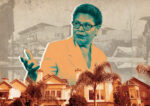Trending
Getting a ‘Handel’ on the UWS
The unconventional 170 Amsterdam Avenue is the best of the three projects the firm has designed on the stretch

Few areas of Manhattan have been as fundamentally transformed over the past few years as the stretch from the west side of Amsterdam at 66th Street to the point where that avenue meets Broadway at 72nd Street. Only one of these blocks, from 70th to 71st, remains entirely unaffected. On the block just to the south of that, the mod, travertine-clad Lincoln Square Synagogue, designed by Hausman & Rosenberg, now stands shuttered. Its congregation has moved one street south, to a new, and far larger building whose undulating façade was ably designed by CetraRuddy.
The three biggest developments along this stretch, however, share the curious distinction of having three different developers all working with the same design firm, Handel Architects.
That the same architectural firm designed all three projects is especially odd considering how radically different each of them is from the others. The first of these developments (and by far the worst) is the Corner, so named because it occupies the southwest corner of Broadway and 72nd Street. Developed by the Gotham Organization, its façade is vaguely historicist in the way in which the Art Deco configuration of its upper floors recalls the summit of the Chrysler Building. And yet, the blatant cost cutting and value engineering of the façade make all too evident the degree to which the result falls short of its apparent intentions.
Five blocks to the south, however, and some three years later, the firm revealed that it had improved greatly over time at Aire, developed by A & R Kalimian Realty. Gone was all trace of historicist reference, and in its place emerged a polished and competently professional tower. The whole structure, rising from a horizontal base, appears to be well made. The main problem it suffers from is that, although it looks like an office tower, it’s actually residential: you would think it had migrated from Midtown and decided to settle on the Upper West Side, a part of the city that’s been emphatically residential since the 19th century.
One block up, however, an entirely new building, developed by Equity Residential, has topped out and is nearing completion at 170 Amsterdam Avenue.
This building, much of whose curtain wall is already in place, could not be more different from Handel Architects’ previous two developments along the stretch. If the Corner, with its echoes of the Chrysler Building, was vaguely historicist, Aire could be described as Neo-Modern in its general adherence to symmetry and modularity. This latest project, however, is Deconstructivist, and is surely the best of the three.
When completed, 170 Amsterdam, a 20-story, 185-foot-tall building, will contain 239 residential units. Sam Zell’s Equity Residential has not yet announced whether it will be rental or condo, but in the past the firm has generally favored rentals.
The most obvious and dominant formal motif of the façade is surely the diagonal cross-hatchings, made of reinforced concrete, that are arrayed somewhat irregularly across the façade on all four sides. The most obvious source of inspiration for the tower is the Sir Norman Foster-designed Hearst Building, completed in 2006, at the corner of Eighth Avenue and 57th Street. But whereas the diagonals of the Hearst Building are strictly regular and modular, and although they were fashioned from steel that lay fairly flat against the surface of the building, the diagonals at 170 Amsterdam rise in fairly high relief from a more conventional matrix of glass curtain wall. In addition, there’s an almost willful variety in the modulation of each of the points of intersection at the new tower.
Above all, the effect of these diagonals creates a sense that the building — which is otherwise conventional looking — has been wrapped in the concrete equivalent of string. Along the eastern and western façades, the stories have been divided by coursing lines that protrude from the surface and are interrupted by the diagonals as they lie flat against the surface of the building.
Other elements of the façade shore up Handel’s Deconstructivist credentials. One of the most effective design conceits is the way in which the diagonals seem to rise directly out of the sidewalk and shoot up the entire surface of the building. There is no attempt to structure the building according to the traditional divisions of base, shaft and summit, or at least base and shaft, that is the rule of thumb in most traditional and Modernist buildings. At other points, most conspicuously on the northern and southern exposures, where the western or back portion of the building comes to an end around the 13th floor, the diagonals seem to trail off into dead ends that are left stranded or suspended above the city. At the same time, over the main east-facing part of the structure, the lines of the diagonals collect in a complicated dance above the building in a way that could almost read as an homage to an early monument of Deconstructivism, Peter Eisenman’s Wexner Center on the campus of Ohio State University. In fact, that building, despite obvious differences, might seem to have exerted a less immediate, but more profound, influence on 170 Amsterdam than even the Hearst Building. And yet, in Handel’s project, the strings have lost the philosophical pretensions of Eisenman’s original. They freely avow their decorative inspiration, and the result is a far more responsible and appealing structure.
In short, 170 Amsterdam is a most unconventional building for the Upper West Side. Almost all of the most recent residential buildings have tended to be historicist or vernacular — and, if not, to be dutifully Neo-Modernist, like Cesar Pelli’s tower on the Fordham campus.
Also, this newest development is conceived as a slab, rather than as a tower. There is surely abundant precedent for this, especially on the Upper West Side. The buildings immediately to the west of 170 Amsterdam offer a good example of this. But in more recent years, this has been a far rarer typology south of 110th Street.
It’s always pleasant to see anyone improving, and so, with this latest project under its belt, and certainly with Aire thrown in as well, Handel Architects has gone a long way to redeeming itself for the sins committed in the design of the Corner.




